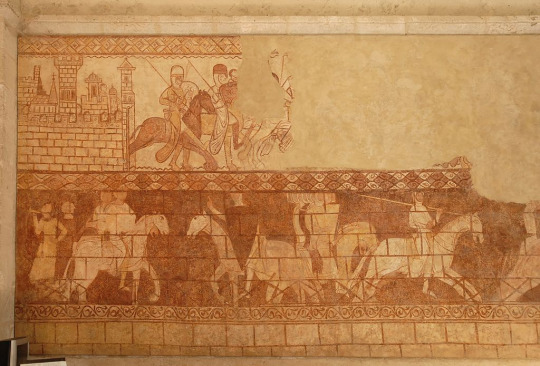#al buqaia
Text
Battle of al-Buqaia 1163 A.D.

(Battle of al-Buqaia, miniature by Jean Colombe from Sébastien Mamerot's book "Passages d'outremer")
In the Battle of al-Buqaia in 1163, the Crusaders and their allies inflicted a rare defeat on Nur ad-Din Zangi, the Emir of Aleppo and Damascus. King Amalric I led the army of the Kingdom of Jerusalem, together with contingents from the northern Latin states, a substantial body of pilgrims who had just arrived from France, and a force brought by the Byzantine governor of Cilicia. For the Christian forces, this victory only gave a brief respite from the sustained Muslim offensive.

(Emir of Aleppo, anon French illumination)
Nur ad-Din proved to be one of the most dangerous enemies the Frankish kingdom had ever faced. Starting out as Emir of Aleppo, he steadily increased his territory at the expense of his Muslim and Latin neighbors, until he gained the great city of Damascus in 1154. He seriously defeated the Crusaders at the Battle of Lake Huleh in 1157, but fell very ill immediately afterward. This event allowed the Franks a chance to recover and, with the help of Thierry of Alsace and an army of pilgrims, to capture Harim castle later in the year. However, an attack on Shaizar failed when Reynald of Châtillon, the Prince of Antioch, quarreled with the other Franks. Consequently, Shaizar soon became the property of Nur ad-Din. In 1158, Thierry and King Baldwin III beat Nur ad-Din at Butaiha, northeast of Tiberias. The year 1160 saw the capture of Reynald, who spent the next 16 years in Nur ad-Din's dungeons. In December 1161, the Byzantine Emperor Manuel I Comnenus married Maria of Antioch and this event gave Antioch a strong protector in the emperor.

(Knight of the Cross attacking Saracens at the battle of al buqaia, late 12th c. mural painting, chapel of Cressac, Charente, France.)
Both Amalric and Nur ad-Din soon became aware of the weakness of Fatimid Egypt, whose government had fallen into a state of decay. After the assassination of Caliph al-Zafir and a series of palace coups, Shawar seized power in 1162, was soon deposed, and appealed to Nur ad-Din for help. Neither the Latin king nor the Muslim emir could afford to let the other capture the rich prize of Egypt. Accordingly, Nur ad-Din sent his lieutenant Shirkuh with an army to support the Egyptian vizier.
While Shirkuh campaigned in Egypt, Nur ad-Din mounted an offensive in Lebanon. Following Latin policy, King Amalric took an army to support his northern vassals, Bohemund III of Antioch and Raymond III of Tripoli. Fortuitously, a large group of French pilgrims led by Hugh VIII of Lusignan and Geoffrey Martel, the brother of William IV of Angoulême, joined the king of Jerusalem. In addition, Konstantinos Kalamanos, the governor of Cilicia brought his Greek warriors to assist the Crusaders. Nur ad-Din was no match for such a formidable combination of enemies and his army suffered a defeat near al-Buqaia (located between Krak des Chevaliers and Beqaa Valley, in modern-day Akkar District, Lebanon). Both Muslims and Franks were impressed by the fighting qualities of the Byzantine soldiers. The negative result of al-Buqaia only made Nur ad-Din more keen for revenge.
14 notes
·
View notes
Text
The 12th c. Templar Chapel of Cressac Saint-Genis

South of Angoulême, in France, lies the small chapel of Cressac Saint-Genis built in the 12th century by the Order of the Temple, more commonly know in modern day as the Knights Templar.

On the north wall of the chapel, are still visible two "friezes" about one meter high each, one above the other, which tell of the events following the second crusade (1147).

The upper register of the north wall recounts the victory won in 1163 by the Crusaders at al-Buqaia, at the foot of the famous fortress called Krak des Chevaliers. The lower register, a little later, represents an exchange of prisoners on the occasion of a truce.

This beautiful little chapel that has survived religious wars, a revolution, and two world wars, is one of but few existing intact examples of Templar architecture and artwork with very rare depictions of the knights themselves among others in the vibrant frescos.
40 notes
·
View notes